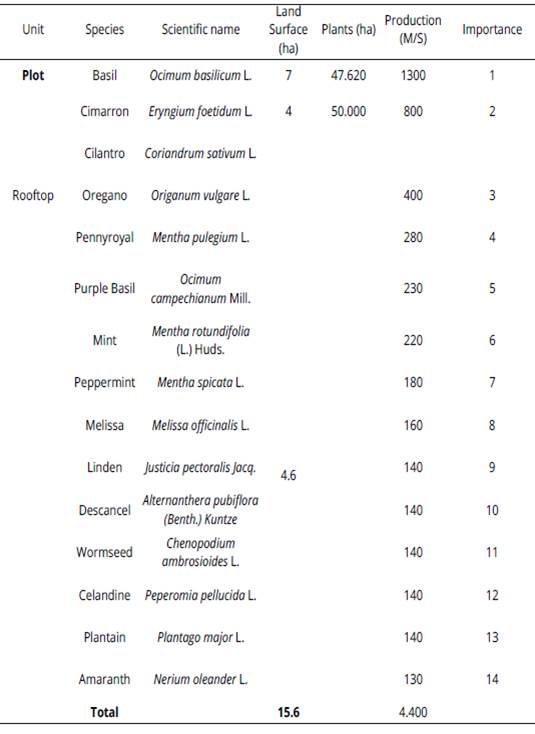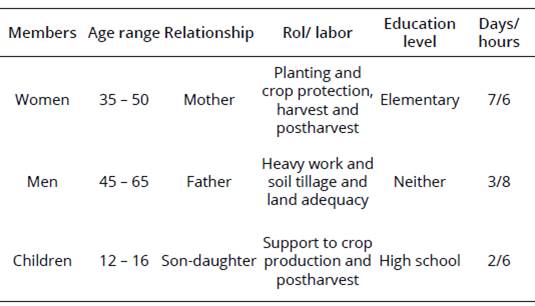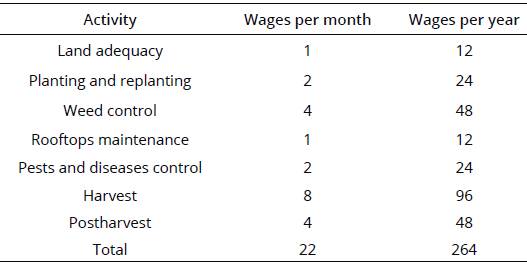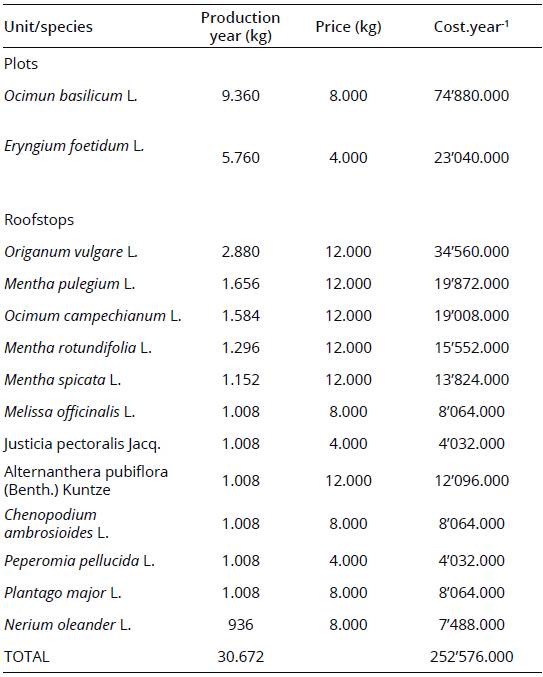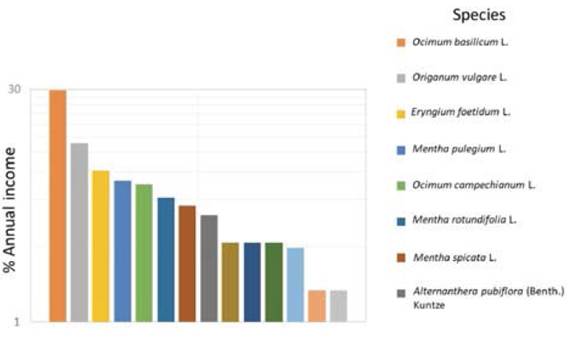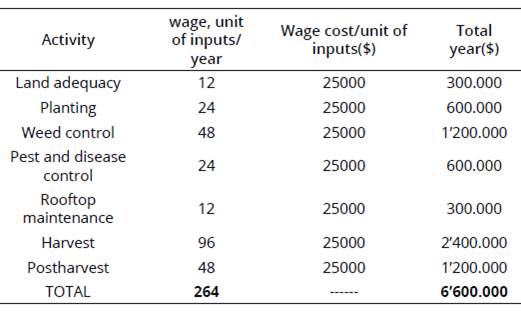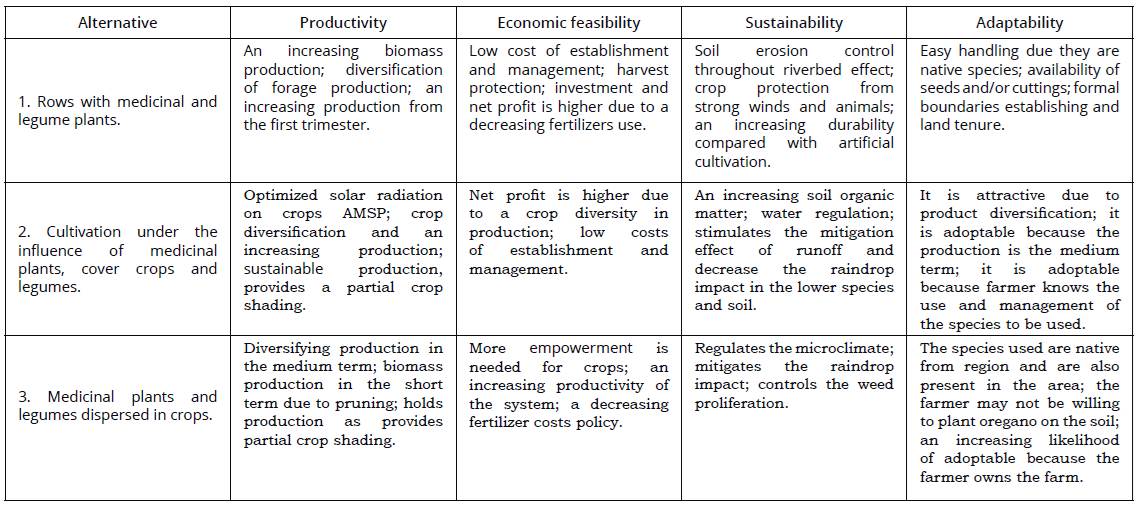Introduction
The use of AMSP is considered as part of history, customs and traditions in many parts of the world, in Colombia there are 156 identified species of aromatic, medicinal and spice plants reported by the naturist laboratories, from which 40.4% (63 species), are registered in the Instituto Nacional de Vigilancia de Medicamentos y Alimentos (INVIMA) Colombia, as natural products with medicinal or pharmacological properties (MADR, 2014).
The special characteristics of the PAMC had achieved a considerable and significant increasing in the national and international demand, medicinal plants contains an active principles that exert a beneficial or harmful pharmacological action on the alive organism, the aromatic plants are those whose active principles are constituted totally or partially by essences and the spices or condiments, are used in food preparation to accentuate or improve their taste, smell and color. Bearing this in mind, a specific market is given for AMSP, especially in the pharmaceutical, food and cosmetic industries. Therefore, due to their importance, we must pay attention to the productive dynamics, which are produced in Colombia in terms of AMSP, since they have great potential in the local, regional, national and international markets, especially in North America and The European Union, from the consumer cultures of products of this nature (Castro, Díaz, Serna, Martínez, Urrea, Muñoz & Osorio, 2013; Caballero-Gallardo, Pino-Benitez, Pajaro-Castro, Stashenko & Olivero-Verbel, 2014).
It is important to note that is prudent to warn in the rural community of La Molana, as in other rural communities in the Choco department of Colombia, there is an employment deficit; whereby many families belonging to these rural communities have supported the AMSP cultivation in a craft and traditional form as an income alternative; which have allowed them to have a vision about AMSP cultivation is not only for their families sustainment, but also helps to preserve the agrobiodiversity. In fact, has granted them a certain degree of importance in the region, due to their invaluable cultural, culinary and medicinal contribution. However, currently there is a little available information of their functional and cultural characteristics of these productive systems.
In this sense, is necessary to wonder: What is the real state of the PU for AMSP in La Molana-Atrato-Chocó, Colombia and how to improve their agroecological conditions?. Given these concerns, the aim of this research was to characterize and analyze the AMSP production systems from La Molana-Atrato, Choco, Colombia based on their biophysical, socio-economic and financial characteristics.
Materials and methods Study area
La Molana, is located to the west of the municipality of the Atrato- Choco over the left margin of the Atrato River. Its geographical position is 05° 36' north latitude and 76° 40' west longitude, has an area of 28.4 km2, with approximately 367 inhabitants and is 13 Km from Yuto municipality. The plant cover which predominates in La Molana is very humid tropical forests (Bmh-T), which is located in the greatest part of the territory that bathes the Atrato River. La Molana has clay loam soils, an average annual rainfall of 8000 mm and a medium temperature of 28°C, with relative humidity higher than 85% (EOT, 2015).
PU identification and selection
For PU identification was applied the methodologies and indicators for agricultural systems evaluation which are addressed to sustainable development (Bolivar, 2011), performing a focal workshop where participated 40 smallholders, primary information was compiled from interviews and semi-structured questionnaires, identifying general characteristics such as type or form of the crop, species variety, cultural work, size of the units, crop age, inputs, tools, education and technological level. According to the above criteria, eight PU were selected (4 plots and 4 rooftops), characterized through a simple random sampling without replacement.
PU characterization in the selected units
The characterization of the productive systems (PU) was developed from the use of the designed methodologies, the implementation and evaluation of agroforestry arrangements (Possu, Jurado & Navia 2009), agrobiodiversity (Valois-Cuesta, Córdoba-Arias, Rentería-Arriaga, 2016) and agroforestry systems (Reed, Van Vianen, Foli, Clendenning, Yang, MacDonald, Petrokofsky, Padoch & Sunderland, 2017), making routes in the selected PU, evaluating the agroecological practices implemented by smallholders and at the same time, were measured and recorded data from the biophysical, socio-economic and financial variables, using semi-structured formulary and working tools such as GPS, tape measure, shovel, machete, scissors trimmers, materials for collection and camera. Taking into account the above mentioned, we assessed the following components:
a) Biophysical diagnosis. The characteristics and general conditions of the PU were identified throughout location and farms georreferencing with coordinates and delimitations with GPS, similarly, was carried out the verification of soil use and importance for the producer through a detailed description by smallholders and spatial distribution as well as importance of their crops, contemplating the location, occupied area per each plot and rooftop, planting distance, planting density, topography, climate, soil, among others.
b) Socioeconomic diagnosis. The socioeconomic diagnosis have allowed to know the hierarchical crop composition, throughout application of a form that includes the background and land tenure, the members information in the PU, education level, and vision of the future, type of empowerment and mode of payment.
c) Financial diagnosis. Profitability is determined by the information gathering related with the production destiny, prices, wage value, economic importance of the crops, finance, labor required, income and PU inputs.
Data analysis for the formulation of agroecological alternatives
At this stage, the analysis of the current situation of the units was carried out, determining their components from collected information in the field (Phase II), supported by agroforestry planning of productive units (APPU) (Somarriba, 2009; Duque, Saldarriaga, Meyer & Saatchi, 2017), therefore, priority factors were determined as follows: problems, needs, limiting factors and agroecological alternatives to improve the productive efficiency, economic and sustainable systems, among others. Subsequently, an adaptability analysis was performed for the proposed alternatives, where the recommendations were enunciated taking into account attributes like: superiority over other alternatives, economic feasibility and observability of results, ease to be implemented and compatibility with the farm climatic conditions.
Results
Bearing this in mind, the present work is intended to present a PU identification and selection in the Molana-Atrato, Choco, Colombia. Table 1, shows the average area of all PU plots, which was 458.3 m2, and the rooftops area, which was of 63.8 m2, demonstrating that the producer handles on average between 6 plots and 18 Rooftops, which confirmed its status of small smallholders, since they have smallholdings and micro holdings lower than 0.5 ha.
Conversely, PU characterization selected in the biophysical diagnosis, for instance, was found that the units are located in the alluvial plains of the middle part of the Atrato river and are mo derately favorable in terms of the environmental conditions for agricultural work. Despite having clay loam soils with moderately acid reaction (pH = 5.9), flat terrain with little pronounced slopes 1-7%; soils originated from alluvial sediments; are moderately deep and its natural drainage is imperfect, are soils that are potentially used to produce specialty crops and ornamental plants.
On the other hand, in Table 2, can observe 40 smallholders that have 15.6 ha for AMSP pro duction in the study area (11 hectares of crops in fields submerged in the native forest and 4.6 hectares in rooftops around the houses), whe re crops like cilantro (Coriandrum sativum L.), cimarron (Eryngium foetidum L.), basil (Ocimun basilicum L.) and oregano (Origanum vulgare L.) are the most important, these species have the largest number of planted hectares, a 70% of the area used and have the highest production bunches weekly.
Table 3, exhibits the labor composition in PU. It was observed that most of the required labor on the PU is supported by breadwinner mothers, carrying out work every day of the week, sometimes they receive support from their husbands and children in some specific activities, where each member plays a key role and spends time established to the necessary work in the system management and utilization.
Table 4, exposes the relation of activities carried out in PU systems. It is evident that PU requires 264 wages per year, from which 73% are represented in harvesting, post-harvest and weed control. As a result, it has long been thought that the labor required in the activities is usually developed for the same family, and are only hired others in special cases, such as, the land adequacy.
Table 5, shows the economic income of the PU where it was found that cilantro (Coriandrum sativum L.), cimarron (Eryngium foetidum L.), basil (Ocimun basilicum L.) and oregano (Origanum vulgare L.), are the species of major economic importance in the area, with an annual production of 9360k, 5760k and 2880 k, respectively, which is equivalent to COP $132'.480.000.
Alternatively, Figure 1, shows the income generation in terms of the farmer participation (%). In fact, the species with major economic participation are cilantro (Coriandrum sativum L.), cimarron (Eryngium foetidum L.), basil (Ocimun basilicum L.) and oregano (Origanum vulgare L.), which represents the 52.45 % of the annuals income of the PU estimated in COP $ 252'.576.000.
Similarly, Table 6 exhibits the major part of the production expenses, which is represented in the harvest, postharvest and weed control, such exes are equivalents to COP $5'.600.000 (192 wages), which represents more than 70% of incomes.
Table 7, exhibits the WOST analysis of PU. weaknesses such as lack of planning and poor crop protection, threats such as loss of soil fertility due to lack of crop rotation and renewal are observed, however, they have sufficient available area for expansion and implementation of crops, which becomes a great opportunity to firm up the clean production agreement and free of chemical inputs.
Table 8, argues different weaknesses, opportunities, threats, strengths, basic needs, priorities and limiting factors of PU, some agroecological alternatives that would improve the productive, economic and sustainable crop efficiency and profitability.
Discussion
Undoubtedly, the number of plants per hectare was not possible to calculate in rooftops due to the complexity and variety of species established in the same unit of land with planting distances highly irregular (Duque, Saldarriaga, Meyer & Saatchi, 2017).
With regard to socioeconomic diagnosis, La Molana has been recognized for its production of ornamental plants, which processed minima lly and are marketed in their natural state in the marketplace of Quibdo-Choco, Colombia. It should be noted that the surpluses are subsis tence consumption. In fact, most AMSP crops are led by small families, especially adult women who are called breadwinner mothers by themselves with ages ranging from 35-60 years, cohabiting, have their own house, electric energy, and are supplied with rainwater and streams. Their PU are clearly organic based on two types of produc tion: Plots and rooftops, which are obtained on average 110 bunches per week per family. In both systems, is applied a traditional management to crops, which is to clean and adjust the planting area, pulling weeds and crop checks. However, these PU do not have technified crops and an adequate space distribution, lack of drainages well defined, a poor phytosanitary crop control, poor crop protection and do not keep planting and performance records.
Nevertheless, to facilitate a more precise as sessment in the land tenure and land value, was recorded that La Molana is denominated under collective title, where most of the PU had achieved land tenure by inheritance, with the exception of some areas that were granted by the Community Council. The value of the PU was impossible to determine because the smallholders expressed ignorance and lack of interest in this regard. Con versely, with the vision to future, the smallholders expect an increasing production of their crops improving their technological and productive process through the potentiation and innovation of clean practices of production in order to supply the local and regional market of AMSP under the terms of organic products and fair trade.
This study evaluated the effects of the econo mic importance of crops, this provides more accu rate and reliable estimates of financial diagnosis, the products obtained from the plots and rooftops are offered on the fresh leaves and on average 96% are transferred to the Quibdó marketplace, while only 4% is for home consumption. It is im portant to highlight the smallholders themselves consume the products obtained from the rooftops in greater proportion.
In Bogotá, Barrientos, Reina & Chacón (2012), reports that AMSP are collected from the field in small quantities for sale without value added (fresh leaves) in the local market places; besides the AMSP not cultivated have a production tech nology and market underdeveloped.
It was possible to determine that in La Molana are handled two types of production: plots and rooftops, where it is evidenced that the PU the handling of the economy is agrarian characterized by be focused on smallholdings and micro hol ding lower than 0.5 ha, destined to small crops combined with other products or collection of wild product. These units do not have irrigation equipment, nor do they have technical manage ment of cultivation and are linked mainly to the domestic market, with direct destination to the market place of Quibdó-Chocó, Colombia.
A possible explanation for this can be addres sed to the sector of AMSP both La Molana as in Bogotá, despite having great social, cultural, culinary and medicinal interest is not generating added value, being that their crops are rustic and low scale, these have retained on small plots and their products are not subject to processes of good agricultural practices and large scale industrial processing, is the case of Mexico and other countries.
Juárez, Aguilar, Bugarín, Juárez & Cruz (2013), reports that the collection and production of aromatic and medicinal herbs is a profitable ac tivity for collectors, smallholders and processors to be considered as an alternative to a growing market and high added value. Is believed to be an outcome of a direct cause of the emerging technological development for the sector of the AMSP and related fields in Colombia, with a new productive line, which has not been given the necessary importance to potentiate it.
This information is useful in the determination of the relation between inputs (252.'576.000) vs outputs (6.'600.000), which is believed to be an outcome of the PU, this type of relationship results profitable and presents a financial profit of COP$245.'976.000 and on the basis of the 40 smallholders, was considered that each unit ge nerates nearly $ 6'.149.400 annual profits with a benefit/cost of COP$38, which can be translated into a COP conversion, that is to say for every Colombian peso invested in the AMSP system, this generates COP $38. These results are comparable in variability to the report by MADR (2014), which defines the types of AMSP smallholders in Colombia. In this sense, in La Molana the AMSP have allowed a contribution of 110 bunches per family weekly, equivalents to 22 kg per week and in the region of Sumapaz (Cundinamarca), Cardona & Barrientos (2011) found out that aromatic plants have an offer around 10 kg per week. In Valle del Cauca (Saldarriaga, Sánchez, Bonilla, Sánchez & Torres, 2010), such information support that currently very few lands are being allocated for cultivation of AMSP in Colombia, where it may conclude that low volumes of market demand are due to the lack of products diversification as of the generation of added value.
Similarly, MADR (2014), holds that the cul tural activities generate more than 1080 wages per ha.year-1, which is equivalent to 4 direct jobs. ha.year-1. Therefore, in La Molana more direct jobs and less wage per ha.year-1 are generated, as is estimated that 1 ha generates around 677 daily wages per ha.year-1 and 5 direct jobs in the PU of AMSP system. This difference is because in La Molana, unlike other regions in the coun try, production systems plots are immersed in the native forest, therefore have no handling or constant visits to crops (96 times year).
In this sense, could be developed further research seeking to improve and increase the performance of each of the components of the systems here described, especially those related to performance in production, organizing the plot and rooftop techniques by separated, the required parameters in families that require counseling as planting distance, need of light and shade, species to be used, among other things. All this in order to favor an increasing productivity and generate higher returns for PU system due to each unit currently generates an average of COP$ 512.450 per month, which is not enough to sus tain a family of at least four members.
The total annual production per hectare for the 14 identified species in the production systems of aromatic, medicinal and spices plants in La Molana is almost 2 tons, much lower than the annual production of basil reported by Tahami, Jahan, Khalilzadeh & Mehdizadeh (2017) and Singh, Soni, Patel & Kalra (2013), whose evaluations in basil equates to more than 10 times this amount.
Conclusion
This methodology can be further improved by including the PU system characterization, which can lead to stage conclusion that all the alternatives mentioned in Table 8 are adoptable for the smallholders, since with them the PU does not suffer many changes in its composition. In addition, to implementing these alternatives are thought to contribute with a decreasing in management costs and relatively low inputs, which had achieved a more attractive attention to smallholders when making decisions.
Given these concerns, could be developed further research seeking to improve and increasing the performance of each system component here described. Finally, our findings support the use of plot and rooftop techniques addressed to improve crop production, the required parameters in families that require counseling as planting distance, need of light and shade, species to be used, among others.














